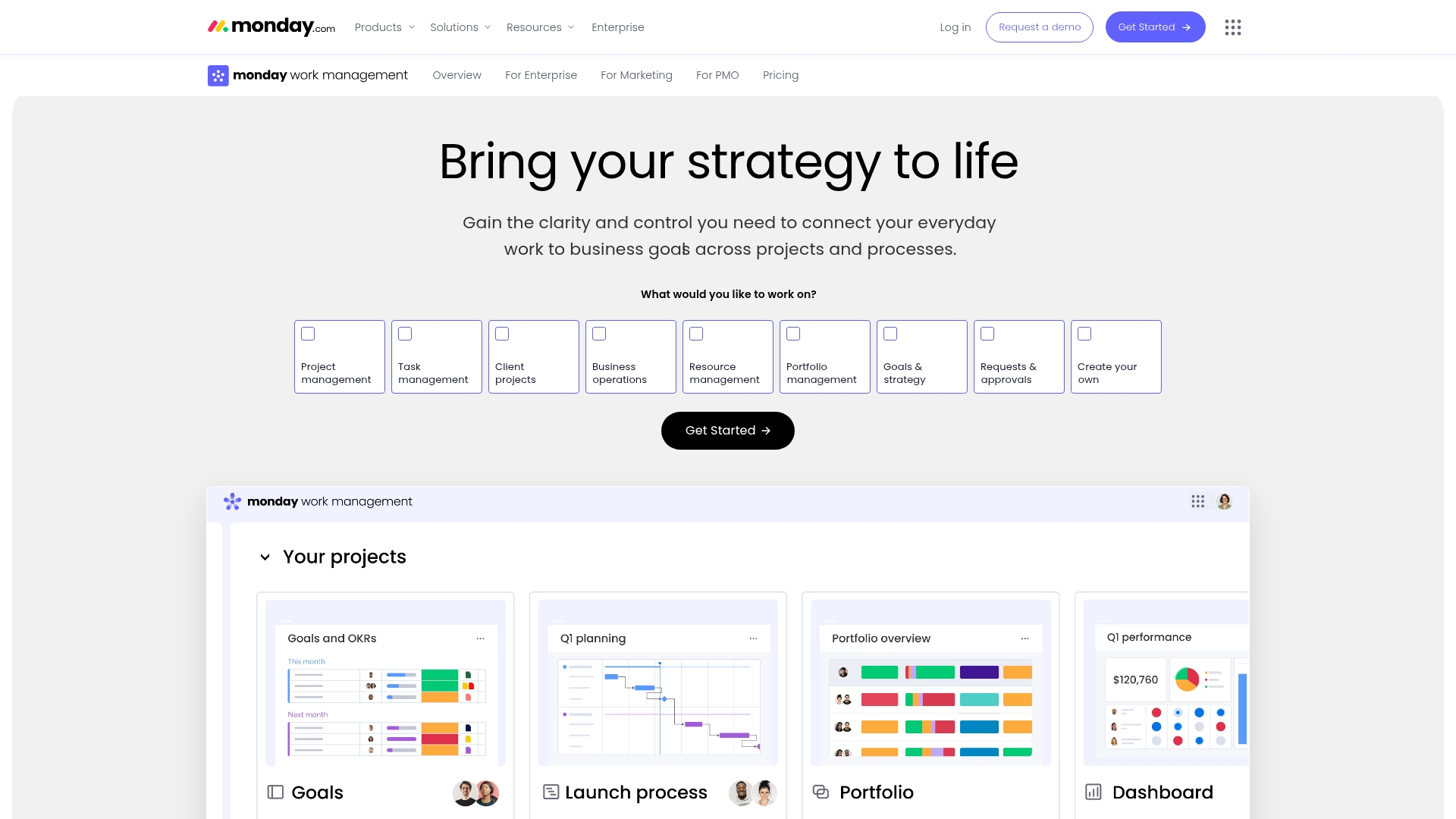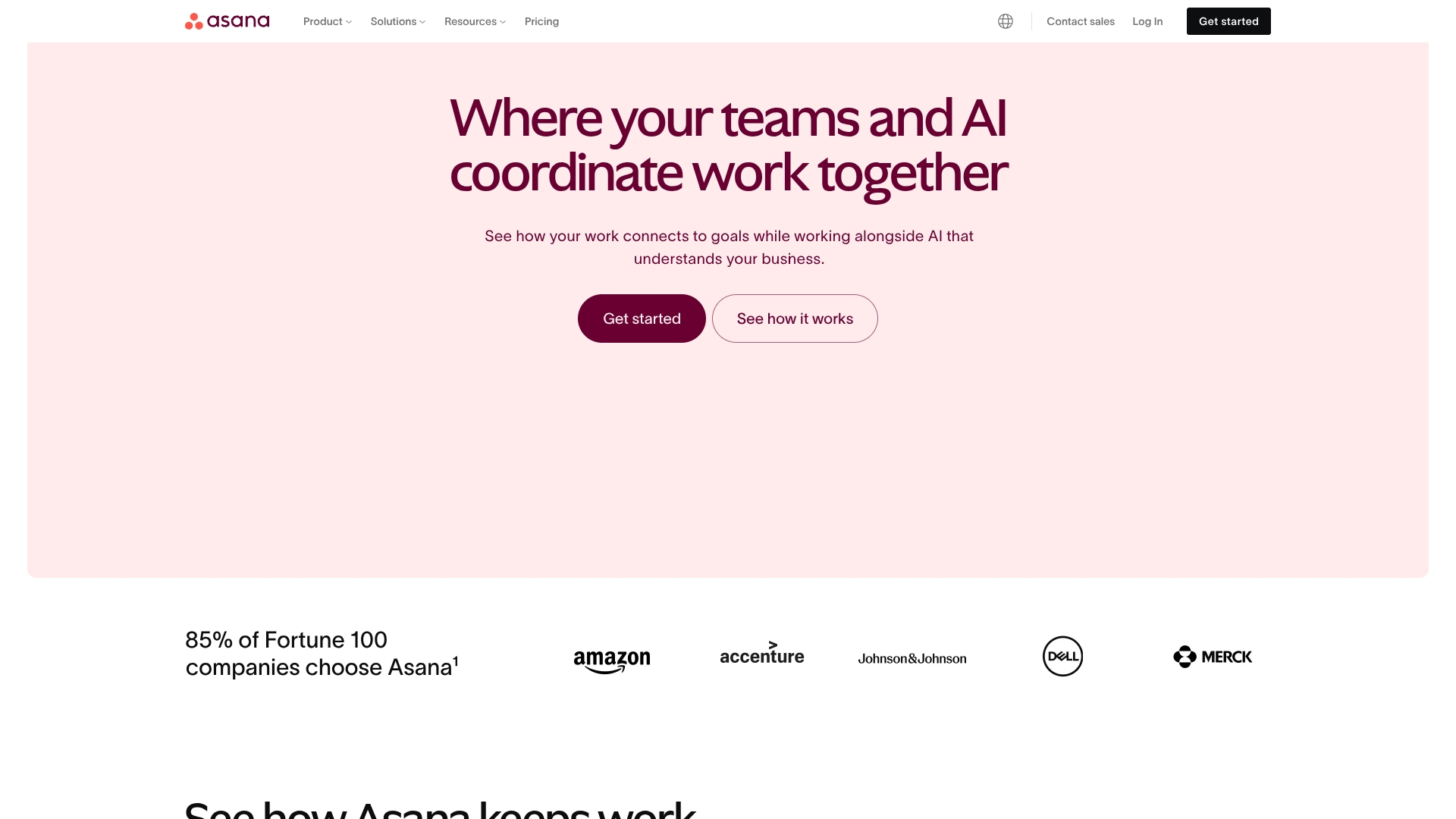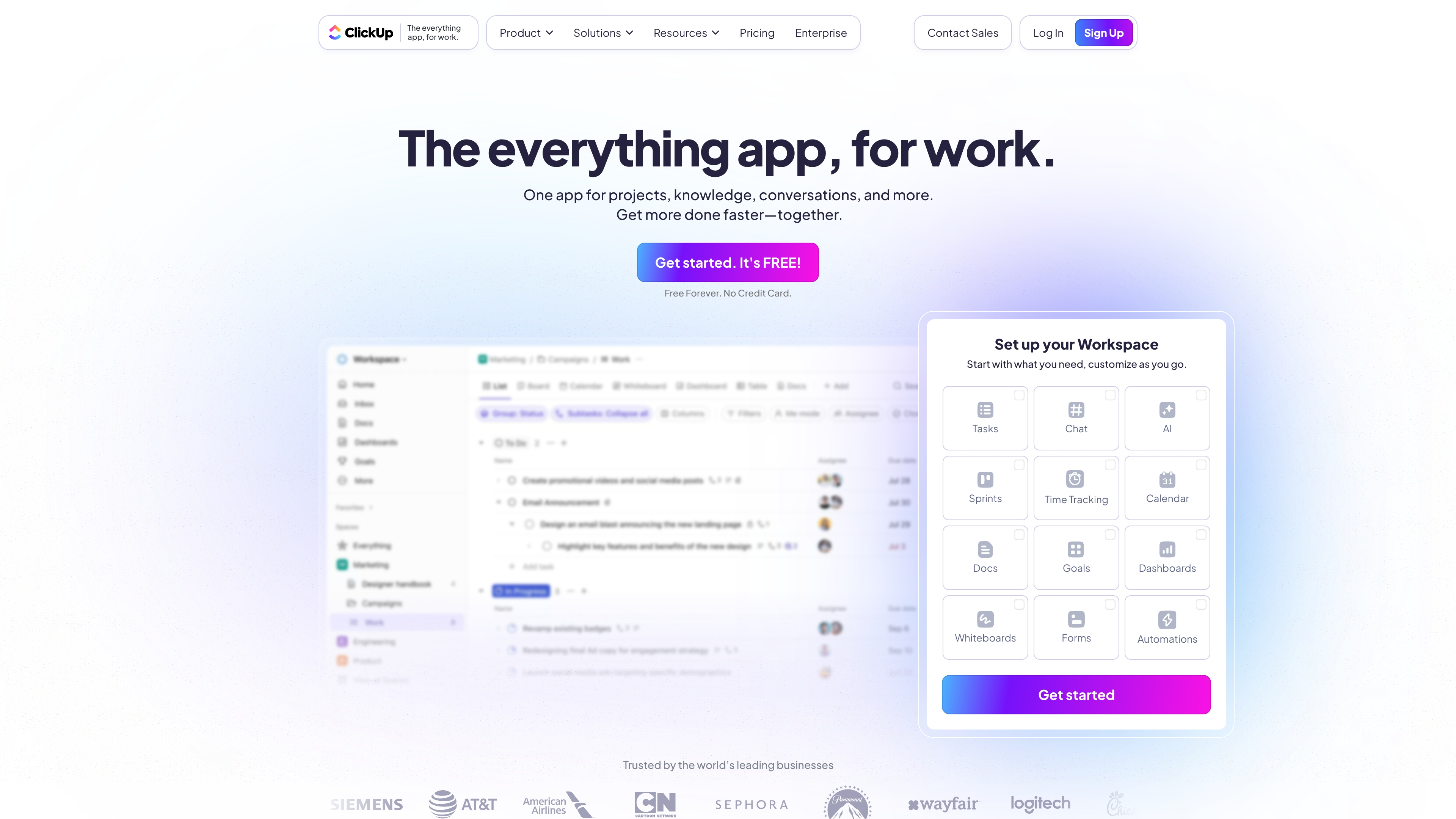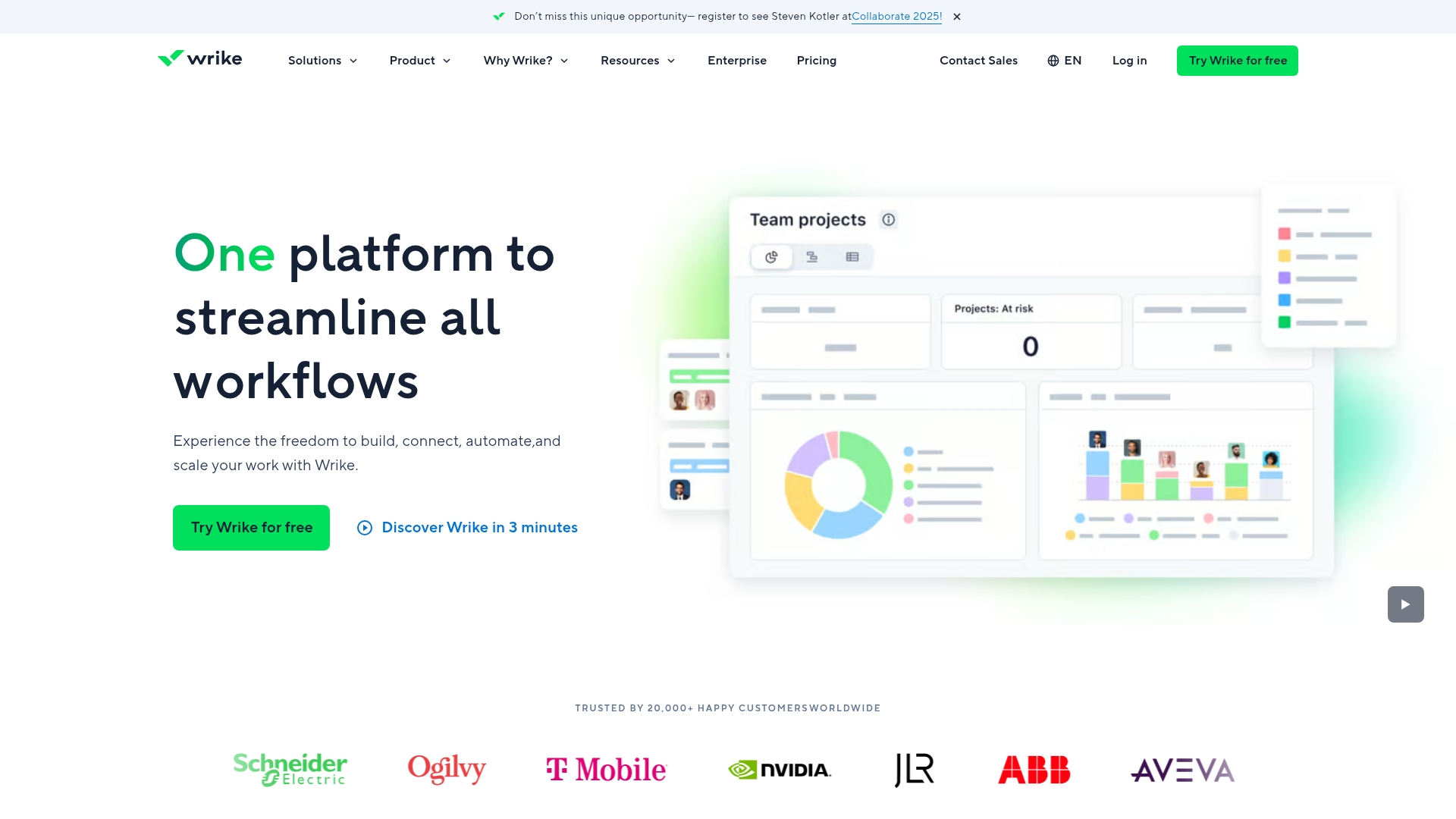The space between a company’s strategic vision and the daily work of its teams is where great plans often lose momentum. Without a system to connect them, teams operate on assumptions, and leaders lack a real-time view of progress. Effective goal management software bridges this divide, transforming abstract objectives into a unified plan for execution and giving everyone a direct line of sight to what matters most.
This guide explores the top platforms available for achieving this alignment. We’ll cover the essential features to look for, compare top options, and explain how to choose the right solution to build confidence and accelerate your team’s performance.
Try monday work managementWhat is goal management software?

Goal management software functions as a strategic GPS for your company, charting a direct course from high-level ambition to daily execution. It is a platform engineered to connect your team’s work directly to your overarching strategy, ensuring every action is not just productive, but purposefully aligned with what truly moves the needle. This system marks the evolution from simply completing tasks to achieving meaningful, measurable outcomes.
Through this technology, scattered efforts converge into strategic alignment. The platform provides every team member and leader with a transparent, real-time perspective on how progress toward key objectives is unfolding across the organization. By centralizing goals, the software naturally dismantles silos and empowers teams to collaborate effectively on the outcomes that matter most.
Frameworks such as OKRs (objectives and key results) supply the foundational “what” and “how,” establishing a precise direction and quantifiable milestones. A superior platform integrates these concepts seamlessly, transforming strategy from a static document into a dynamic, integral component of your team’s daily operations and collective success.

15 top goal management software tools
Choosing the right goal management software means turning strategy into action and unifying your team around what matters most. Below is a quick comparison of the top goal management platforms, so you can find the best fit for your needs. Take a look and then keep reading for a deeper look at each software option.
Use this table to quickly compare your options and zero in on the right platform to accelerate your team’s momentum. Now, let’s take a deeper look at each software.
1. monday work management
monday work management excels at converting abstract goals into streamlined execution by linking strategic vision directly to daily work items. Its strength lies in a flexible goal management architecture that adapts to any methodology — from OKRs to SMART goals — making it a prime choice for mid-sized to large organizations focused on achieving cross-departmental alignment.
Use case: Midsized to large organizations that need a customizable Work OS to align strategy with execution across teams
Key features
- Linked boards and items to connect company-wide objectives to team and individual goals
- Customizable dashboards that update automatically to monitor goal advancement and milestones
- Built-in responsibility tracking and automated progress reporting to keep everyone aligned and motivated
Pricing
- Free: $0 forever for up to 2 seats, including 3 boards and 200+ templates
- Basic: $9/seat/month with unlimited items and 5GB storage
- Standard: $12/seat/month including timeline views and 250 automations & integrations per month
- Pro: $19/seat/month with advanced formula columns and 25,000 automations & integrations per month
- Enterprise: Custom pricing with portfolio management, advanced analytics, and 250,000 automations & integrations per month
- Annual billing saves 18% compared to monthly rates
- Nonprofit discounts are available
Why it stands out
- Complete customization: Unlike rigid goal software, monday work management lets you build the exact system your organization needs. While this flexibility can have a slight learning curve, it empowers you to create a process that truly fits your team without needing technical help.
- Visual clarity: The platform’s colorful, intuitive interface makes goal tracking engaging and accessible for teams at every level, from executives to individual contributors.
- Seamless integration: Connect goals directly to project execution with built-in resource management, time tracking, and portfolio oversight capabilities.
Advanced AI features
- AI-powered risk analysis: Identify potential roadblocks and project delays before they impact your goal timelines, helping teams stay proactive.
- Intelligent resource allocation: Get AI-driven recommendations for optimal team capacity and resource distribution across multiple goal-related initiatives.
Automations
- No-code workflow builder: Create sophisticated goal management automations without technical skills, from simple status updates to complex multi-step approval processes.
- Large library of pre-built recipes: Choose from a wide variety of ready-made automation templates for common goal management scenarios like quarterly reviews, milestone celebrations, and deadline escalations.
- Enterprise-scale automation: Handle up to 250,000 automations and integrations per month on Enterprise plans, supporting complex goal hierarchies across large organizations.
Integrations
- Seamless tool connectivity: Connect monday work management with your existing tech stack including Slack, Microsoft Teams, Google Workspace, and Salesforce for unified goal tracking.
- Open API access: Build custom integrations that pull goal-related data from any system, ensuring your goal management software becomes the central hub for strategic execution.
- Popular enterprise connections: Native integrations with tools like Jira, Tableau, and Power BI let you incorporate goal progress into existing reporting and analytics workflows.
2. Asana
Asana brings structure to goal management, evolving it from scattered spreadsheets into a cohesive system that links strategic objectives with daily work. The platform’s specialty is OKR-based goal tracking with automatic progress updates, a feature that makes it particularly suitable for teams prioritizing transparency without the burden of manual reporting.
Use case: Teams that want transparent OKR-based goal tracking with automatic progress updates
Key features
- AI-powered goal creation that drafts SMART objectives from simple descriptions
- Automatic progress tracking that updates goals in real-time based on completed work
- Hierarchical goal structure that shows how individual contributions ladder up to company objectives
Pricing
- Personal: Free forever for up to 10 teammates
- Starter: $10.99/month per user (billed annually) or $13.49/month (billed monthly)
- Advanced: $24.99/month per user (billed annually) or $30.49/month (billed monthly) – includes Goals feature
- Enterprise: Custom pricing (contact sales)
- Enterprise+: Custom pricing (contact sales)
- 50% discount available for eligible nonprofits on annual Starter and Advanced plans
Considerations
- Goal management features are only available on Advanced plans and above, which may be costly for smaller teams focused solely on goal tracking
- Some users report limited customization options for goals, such as the inability to add custom fields or reorder goals freely
3. ClickUp
With its comprehensive goal management software, ClickUp helps organizations transform ambiguous objectives into trackable, actionable targets. The platform’s automated progress tracking, which is tied directly to work item completion, makes it an excellent fit for startups and growing teams that require flexible goal-planning platforms without unnecessary complexity.
Use case: Startups and growing teams looking for flexible goal planning with automated task-linked progress tracking
Key features
- Goals update in real-time as connected tasks are completed, eliminating manual status updates
- Set numerical, currency, true/false, or task-based targets to measure progress across different goal types
- Organize group-related objectives into folders for OKRs, sprint cycles, or weekly scorecards with clear visual progress tracking
Pricing
- Free Forever: $0/month with unlimited tasks, basic goal management, and 60MB storage
- Unlimited: $7/month per user with unlimited storage, advanced goal features, and native time tracking
- Business: $12/month per user with unlimited dashboards, advanced automation, and workload management
- Enterprise: Custom pricing with white labeling, advanced permissions, and dedicated customer success manager
- Discounts available for nonprofits, students, educators, and startups with 30-day money-back guarantee
Considerations
- The native Goals feature can feel limited compared to ClickUp’s robust task management capabilities, with some users preferring to build custom goal tracking systems
- The extensive customization options and feature set can create a steep learning curve for new users seeking simple objective setting software
4. Smartsheet
Smartsheet leverages a familiar spreadsheet-like interface to build powerful goal management systems that connect strategic objectives directly to project execution. The platform’s focus on milestone-driven goal tracking with Gantt chart integration makes it a strong contender for project-heavy organizations needing to align daily work with long-term aims.

Key features
- Pre-built SMART goals and OKR templates that can be customized for any organizational structure
- Dynamic charts and KPIs that provide instant visibility into goal progress across teams and departments
- Workflow automation that sends reminders, requests updates, and notifies stakeholders about milestone achievements
Pricing
- Pro: $9 per user/month (billed monthly, for up to 10 users)
- Business: $32 per user/month (billed monthly, for 3+ users)
- Enterprise: Custom pricing (contact sales for a quote)
- Add-ons: Available for features like Dynamic View and Data Shuttle
- Free 30-day trial available
Considerations
- Requires significant setup time to build comprehensive goal management systems from scratch, which can be overwhelming for teams without dedicated Smartsheet expertise
- Advanced goal management features like Dynamic View and enhanced reporting are often locked behind higher-tier plans or paid add-ons, increasing total cost of ownership
5. Wrike
Offering deep customization, Wrike provides a comprehensive work management solution for teams that demand flexibility in their goal management strategy. The platform excels at linking strategic objectives to daily execution via its robust OKR framework and advanced reporting, making it especially valuable for medium to large organizations with intricate workflows.
Use case: Medium to large organizations requiring deep customization and advanced OKR alignment within complex workflows
Key features
- Multi-level OKR management cascades company goals down to individual work items with real-time progress tracking
- Custom dashboards and automated reporting deliver organization-wide goal visibility directly to stakeholders
- 400+ integrations, including Slack, Microsoft, Google Workspace, and Salesforce for comprehensive workflow connectivity
Pricing
- Free: $0/month with basic project management and limited active tasks
- Team: $10/month per user (billed annually) for small teams with unlimited projects and custom fields
- Business: $25/month per user (billed annually) for advanced reporting and resource planning
- Enterprise: Custom pricing with SAML SSO, advanced security, and enhanced automation
- Pinnacle: Custom pricing for complex organizations with advanced BI and budget planning software features
Considerations
- Steep learning curve due to extensive customization options that can overwhelm new users
- Higher-tier pricing required for advanced goal tracking features, making it costly for smaller teams
6. Deel
Deel redefines global workforce management by integrating performance tracking with robust goal management capabilities. The platform’s strength is connecting individual objectives to company-wide goals through its OKR framework, making it an ideal solution for distributed teams managing remote employees across multiple countries.
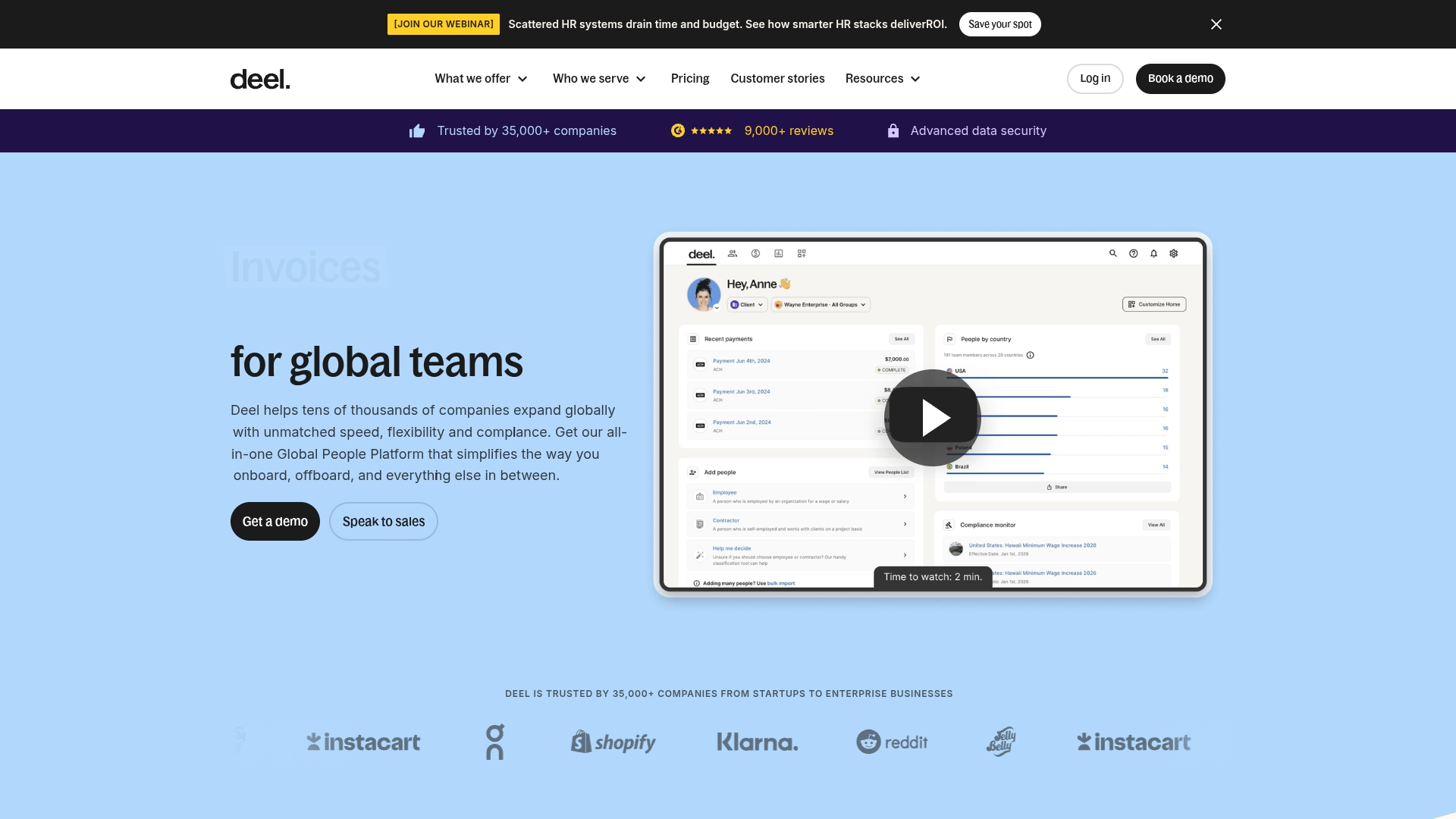
Key features
- OKR framework implementation to set parent goals and sub-goals with automatic progress tracking and weighted metrics to reflect relative importance across teams
- 360-degree performance integration to connect goal achievement directly to customizable performance reviews, peer feedback, and career development planning
- Global compliance alignment to manage goal setting and performance tracking while maintaining compliance across 150+ countries through built-in legal and HR frameworks
Pricing
- Deel EOR: $599/month per employee (includes full legal employment and HR support)
- Deel Contractor Management: $49/month per contractor (includes automated contracts and payments)
- Deel Global Payroll: Starting at $29/month per employee (unified payroll processing)
- Deel Engage: Available as add-on module (pricing varies based on core plan selection)
Considerations
- Goal management features require purchasing the separate Deel Engage add-on, increasing overall platform costs for teams seeking standalone objective setting software
- Limited advanced analytics compared to specialized goal tracking tools, with some users requesting more comprehensive reporting capabilities for goal achievement software
7. ThriveSparrow
ThriveSparrow elevates goal management from a series of scattered objectives into a force for unified organizational success with its comprehensive OKR platform. It specializes in connecting individual goals directly to the company’s mission and impact, making it a go-to for HR leaders and people-centric organizations that value transparent goal alignment.
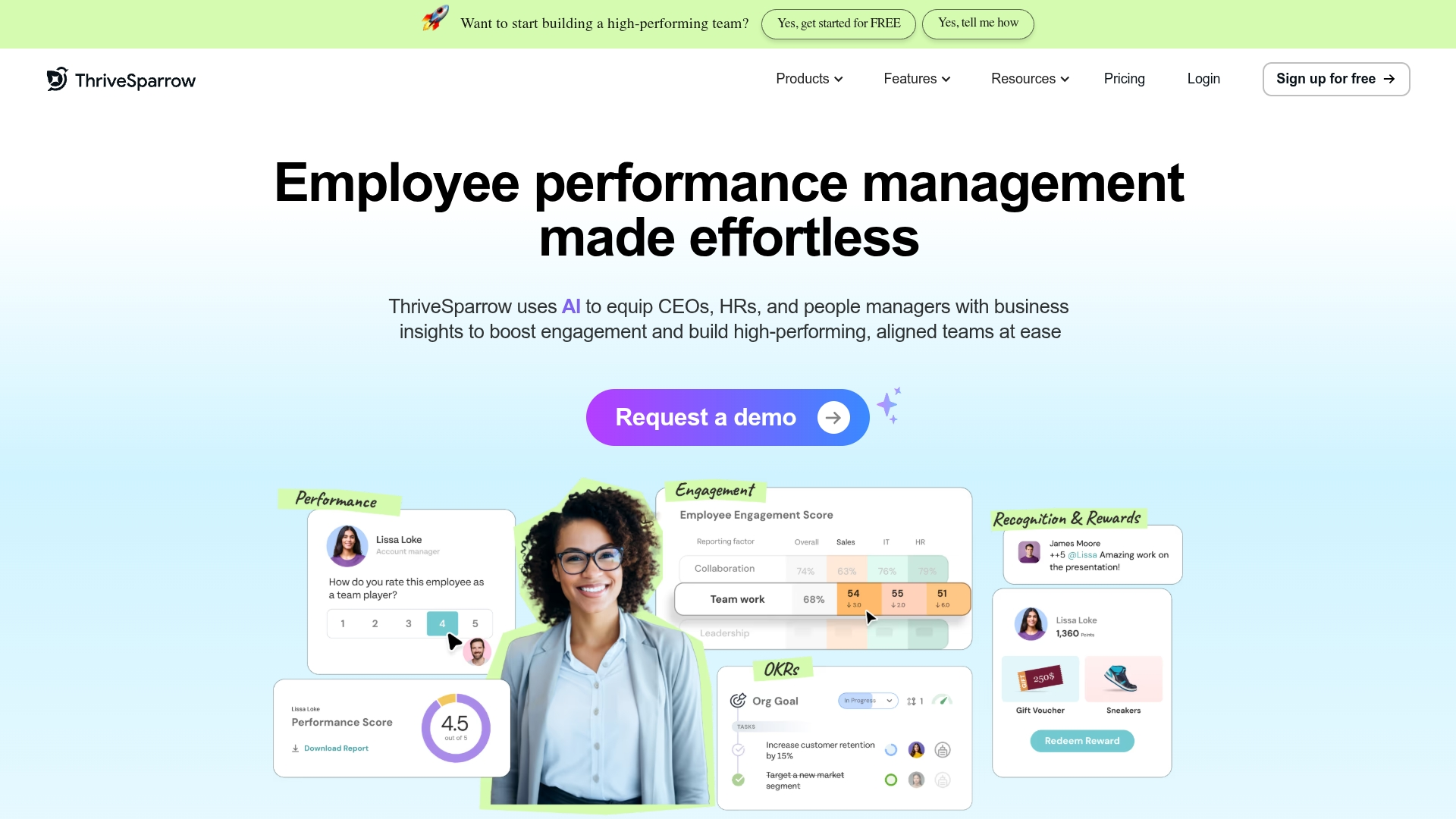
Key features
- Real-time OKR tracking with customizable metrics using numbers, percentages, and currency
- Cascade View visualization that connects goals across organizational hierarchy for complete alignment
- Automated goal cycles with quarterly timelines and seamless integration with Slack, Google Workspace, and Microsoft Teams
Pricing
- Goals (OKRs): $3/user/month (billed annually)
- Performance: $5/user/month (billed annually)
- Engage: $3/user/month (billed annually)
- Kudos: $2/user/month (billed annually)
- Free plan: Available to get started
Considerations
- Limited multi-language support may restrict global team adoption
- API access is described as limited, which could constrain integration possibilities for some organizations
8. PerformYard
PerformYard offers a comprehensive performance management suite that seamlessly integrates goal management with employee reviews and feedback cycles. The platform’s highly flexible and customizable workflows can adapt to any organization’s performance philosophy, making it an excellent all-in-one solution for mid-sized companies.
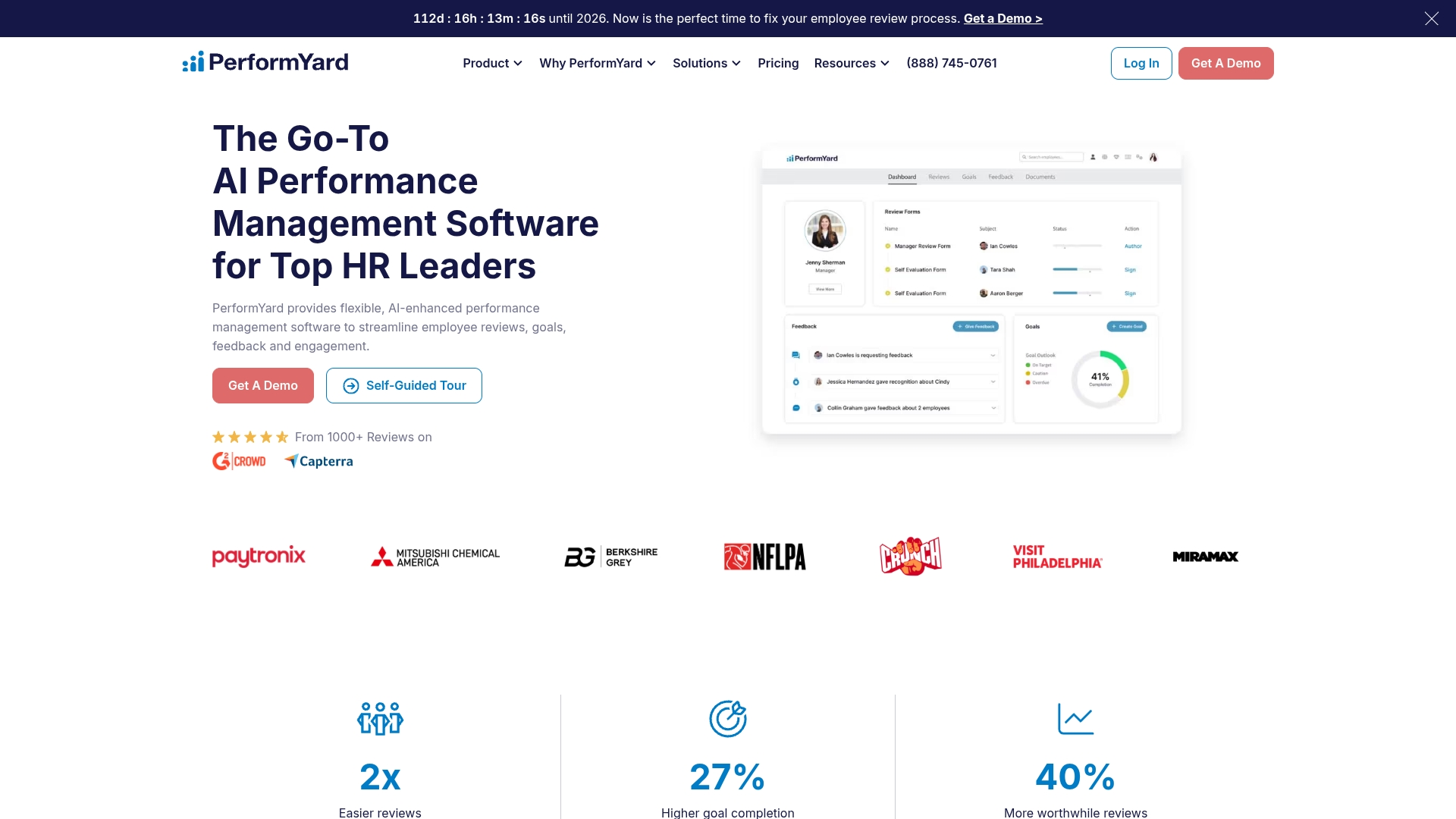
Key features
- Cascading goal alignment that connects individual objectives to company-wide strategic priorities
- Integrated performance reviews that incorporate goal progress directly into evaluation forms
- Visual reporting and analytics with charts and graphs for tracking progress across teams and departments
Pricing
- Performance Management: $5-10 per person per month (billed annually)
- Employee Engagement add-on: $1-3 per person per month when bundled
- Meetings add-on: $2-4 per person per month when bundled
- Surveys add-on: $2-4 per person per month when bundled
- Enterprise discounts available for larger organizations
Considerations
- Limited OKR functionality compared to dedicated objective setting software platforms
- Initial setup requires significant backend configuration to fully customize workflows
9. Teamflect
By operating directly within Microsoft Teams, Teamflect provides a comprehensive performance management solution that changes how organizations approach goal setting and employee development. Its seamless integration with Microsoft 365 makes it the perfect choice for teams already embedded in that ecosystem who wish to streamline their tools without switching applications.
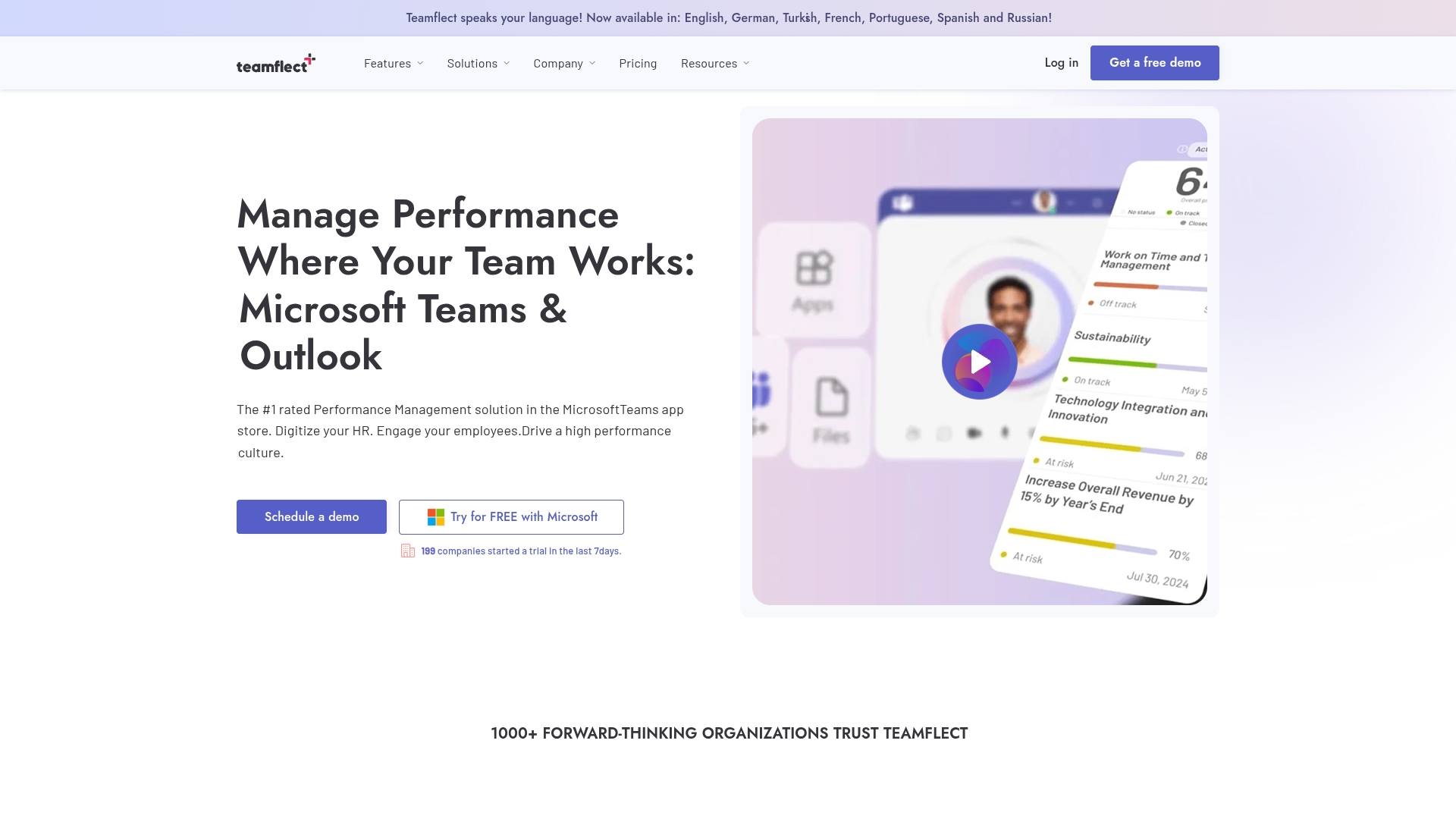
Key features
- Cascading goals that connect individual objectives to departmental and organizational targets
- Automated check-in reminders sent directly through Microsoft Teams to maintain accountability
- Multiple goal measurement types including percentage, currency, and binary completion tracking
Pricing
- Starter: Free for up to 10 users
- Essential: $7/month per user (annual billing) or $9/month (monthly billing)
- Professional: $11/month per user (annual billing) or $14/month (monthly billing)
- Volume discounts available for larger teams
- Nonprofit organizations receive up to 60% discount
- No additional fees for implementation, support, or training
Considerations
- Heavy reliance on Microsoft ecosystem may limit appeal for organizations using other collaboration platforms
- Smaller company size compared to enterprise-focused competitors may affect scalability for very large organizations
10. Quantive Results
Quantive Results is an enterprise-grade OKR platform designed to turn strategic planning into measurable outcomes. It specializes in high-level goal management and strategy execution, making it a powerful asset for large organizations that require data-driven alignment across complex corporate hierarchies.
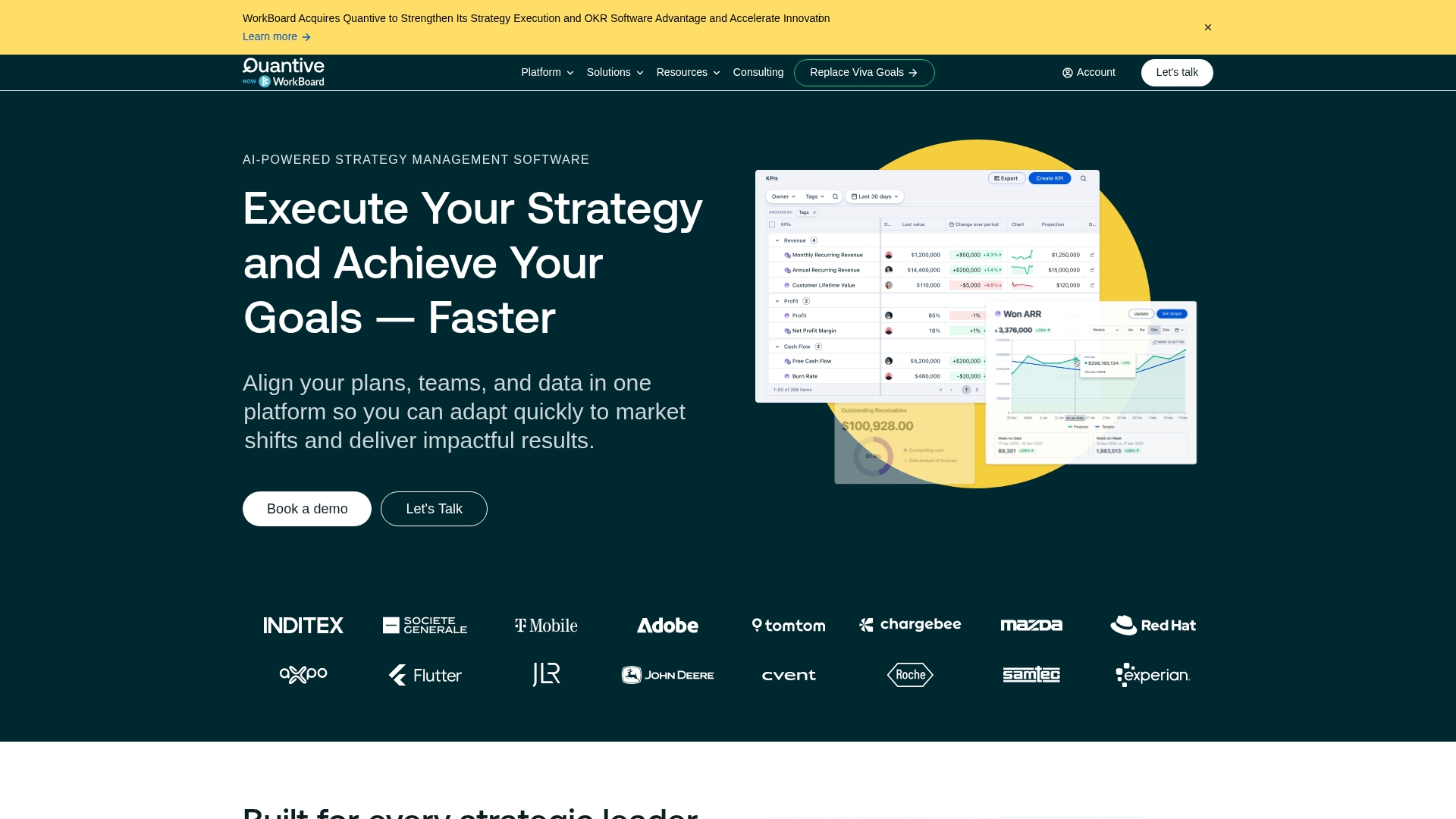
Key features
- AI-powered goal suggestions and strategic intelligence to optimize OKR creation and deployment
- Over 170 native integrations that automatically sync progress data from existing business systems
- Collaborative goal creation tools with virtual whiteboards for stakeholder alignment and voting
Pricing
- Teams: Custom quote required – includes essential capabilities for smart planning, goal tracking, and reporting
- Business: Custom quote required – adds smart execution, advanced reporting, enhanced privacy, and success services
- Enterprise: Custom quote required – includes smart reporting, advanced customization, enterprise user management, and dedicated services
Considerations
- Advanced features like custom dashboards can be complex and may require developer assistance
- Mobile app has reported issues with login functionality and performance lags
11. Kallidus Perform
Kallidus Perform shifts organizations from traditional annual reviews to a continuous performance management system that connects employee development directly to business objectives. The platform’s unique integration of learning and performance management makes it ideal for HR teams focused on building development-driven cultures. This unified approach helps align individual growth with strategic goals while promoting ongoing feedback.
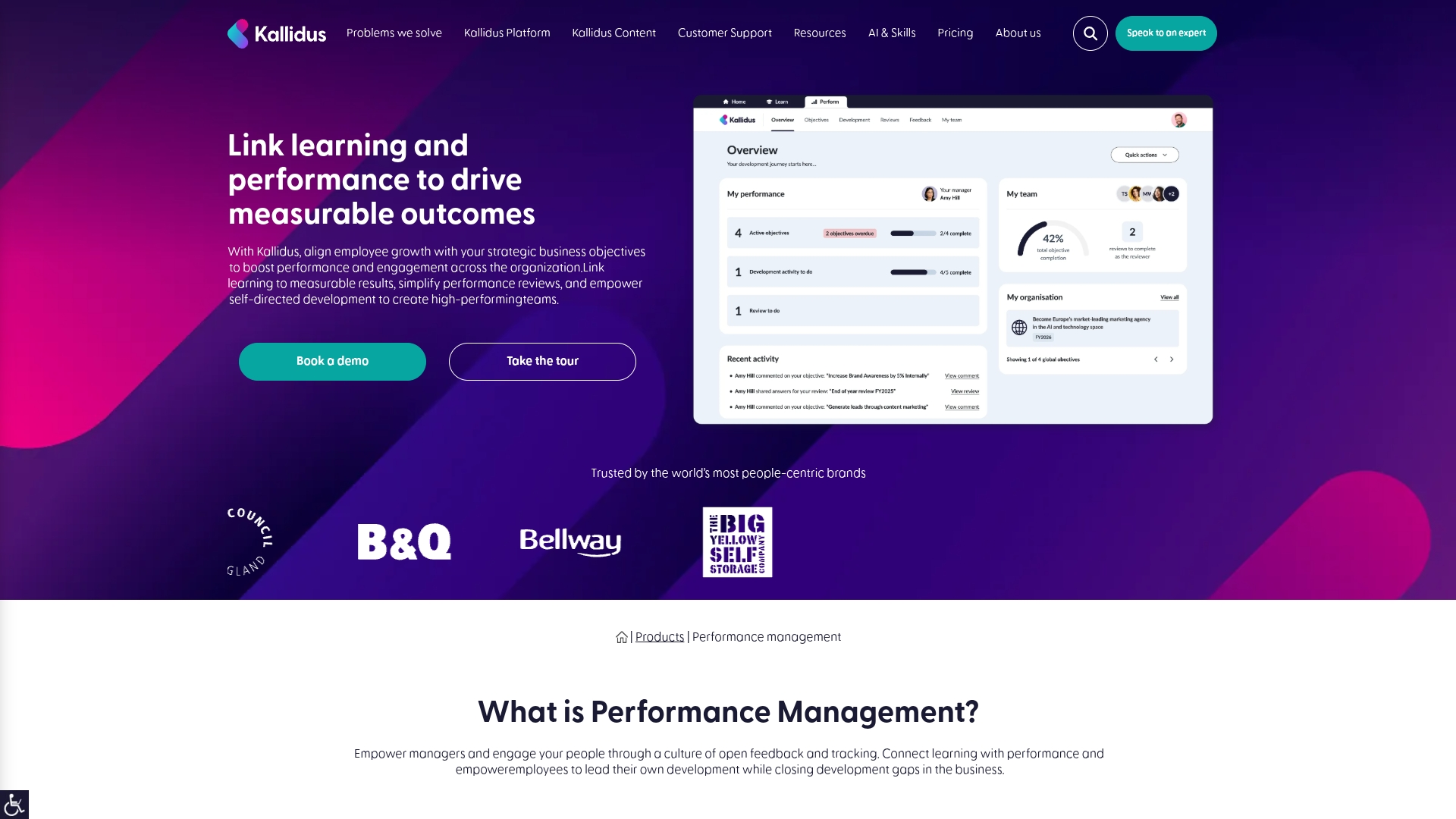
Key features
- AI-powered SMART objectives guidance that helps users create specific, measurable, achievable, relevant, and time-bound goals
- Continuous feedback system with 360-degree performance reviews that include self, manager, and peer assessments
- Integrated learning and performance management that links individual goals to development plans and training activities
Pricing
Custom pricing available upon request.
Considerations
- Limited transparent pricing information requires direct sales contact for cost evaluation
- Some users report wanting additional features like specific timescales for self-development areas within the platform
12. Synergita
Synergita helps organizations evolve from traditional annual reviews to continuous performance conversations that generate tangible results. With a focus on matrix goal management and real-time feedback, the platform is well-suited for companies with complex reporting structures and rapidly growing teams.
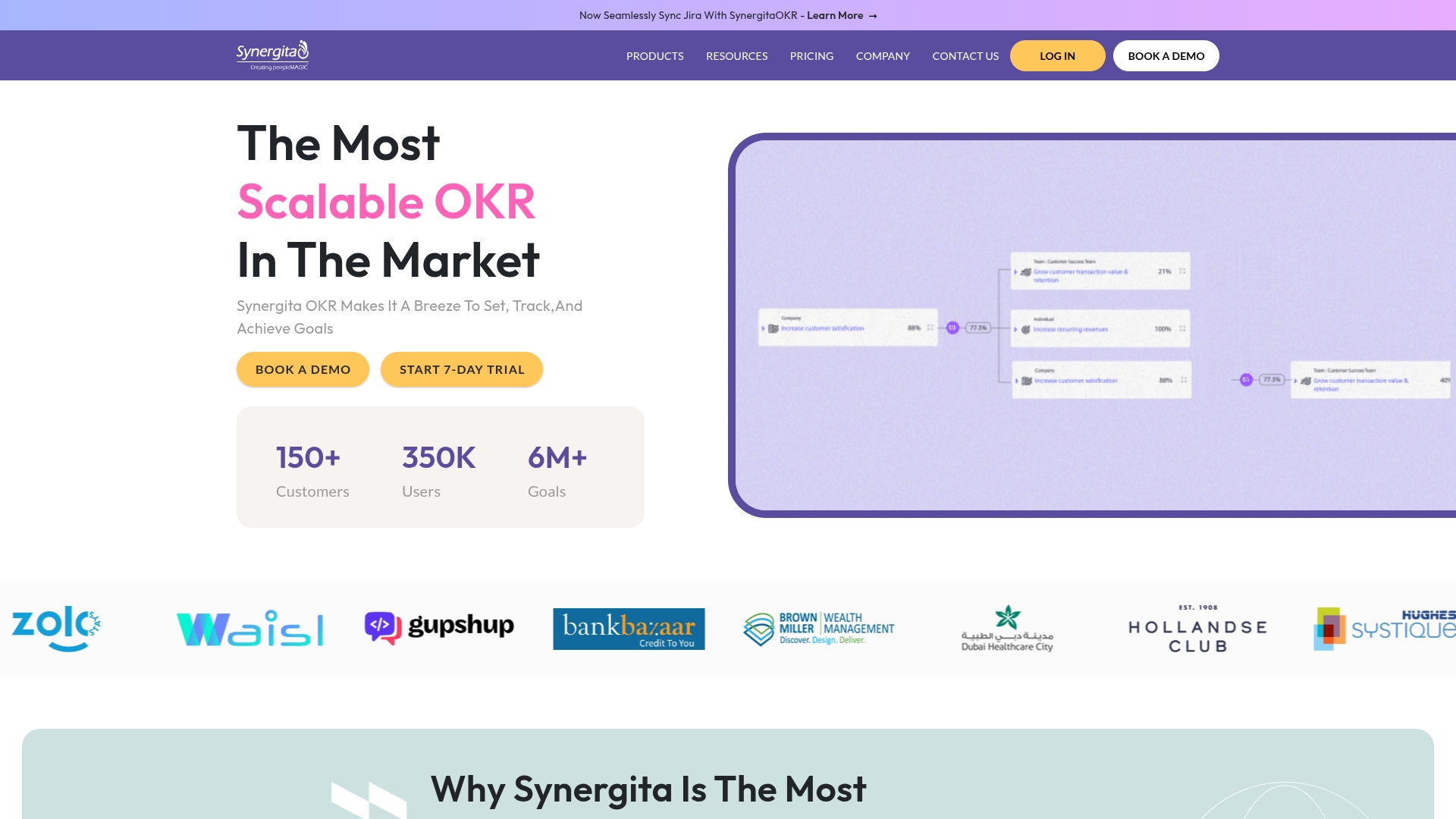
Key features
- Matrix goal management that maps each objective to the appropriate functional manager for targeted feedback
- SMART goals and OKR frameworks with real-time progress tracking and status indicators
- AI-powered sentiment analysis that interprets qualitative feedback to gauge employee engagement
Pricing
- Engage: $2/month per user (billed annually)
- Perform: $4/month per user (billed annually)
- Perform Plus: $7/month per user (billed annually)
- Free 7-day trial available
- Bulk purchase discounts offered upon request
Considerations
- OKR functionality may not be as specialized as dedicated OKR-first platforms
- Better suited for mid-market and enterprise companies rather than small businesses with fewer than 50 employees
13. Goalscape
With its unique approach, Goalscape renders complex goal structures as visual maps that make priorities instantly clear. This distinctive goal planning software specializes in a circular, hierarchical goal visualization, making it an excellent match for visual thinkers, teams, and individuals who need to grasp the big picture while managing detailed sub-goals.

Key features
- Visual goal mapping with circular, hierarchical displays that show relationships between main goals and sub-goals
- Dynamic prioritization tools that let you resize goal segments to reflect their relative importance
- Real-time collaboration features with Microsoft Teams integration for seamless team alignment
Pricing
- Free Plan: 14-day trial with full Pro functionality, unlimited read-access after trial expires
- Pro Plan (Monthly): $9.90/month, billed monthly
- Pro Plan (Yearly): $8.25/month, billed annually at $99 (saves 2 months over monthly)
- Enterprise Plan: Custom pricing with dedicated server, corporate branding, and priority support
- Volume, academic, and nonprofit discounts available upon request.
Considerations
- Limited to web browser access on mobile devices with no dedicated mobile app
- Visual customization options are somewhat restricted compared to traditional project management platforms
14. GoalsOnTrack
GoalsOnTrack provides a comprehensive goal achievement system engineered for individuals and small teams aiming to convert aspirations into actionable results. The platform’s structured approach to goal decomposition, using proven methodologies like S.M.A.R.T. frameworks, makes it ideal for professionals who favor a systematic path to personal and professional development.
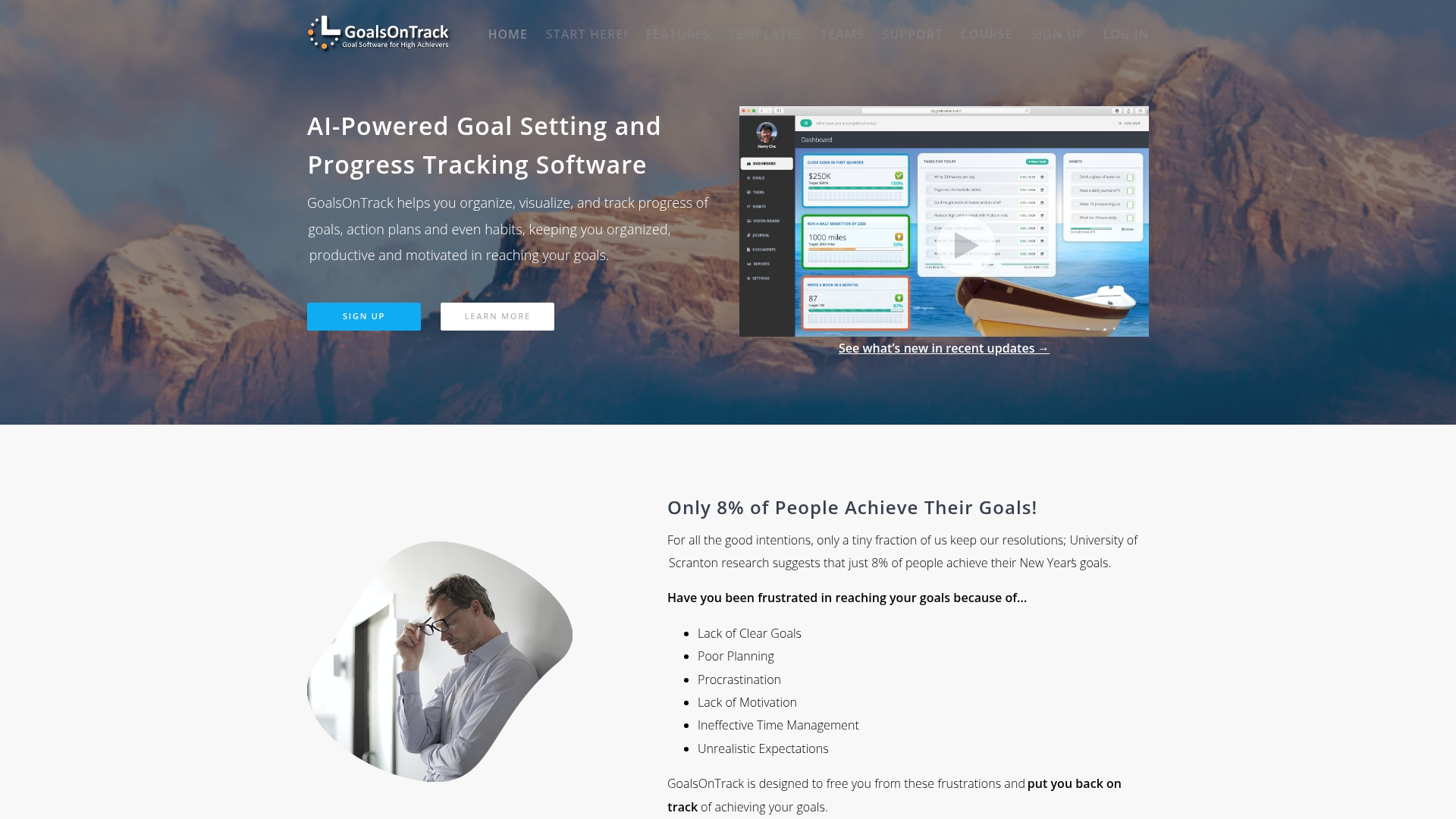
Key features
- Multi-level goal breakdown that allows you to decompose large objectives into up to five levels of manageable sub-goals and actionable items
- Integrated habit tracker with visual strength indicators and calendar check-ins to build supporting behaviors that drive goal achievement
- Vision board creator with customizable slideshows and music to maintain motivation and visualize success throughout your journey
Pricing
- Annual membership: $68/year (approximately $5.67/month)
- 30-day unconditional money-back guarantee
Considerations
- Mobile apps receive frequent criticism for being buggy and less functional compared to the comprehensive web version
- The user interface feels dated compared to modern goal planning software alternatives, which may impact user experience for teams accustomed to contemporary design standards
15. Microsoft Planner
Integrated into the familiar Microsoft 365 ecosystem, Microsoft Planner organizes scattered tasks into coherent workflows. The platform’s primary advantage is its seamless connection with existing Microsoft tools, making it a straightforward choice for teams already invested in the Office suite who need simple goal management capabilities.
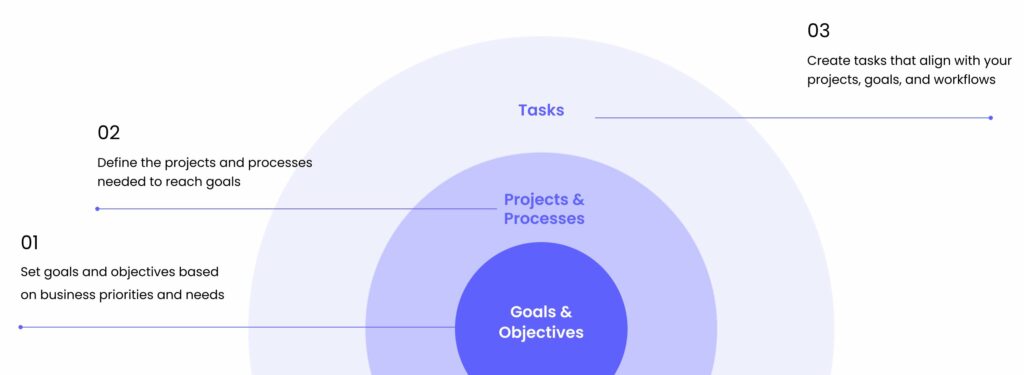
Key features
- AI-powered goal creation through Copilot that helps teams set meaningful, measurable objectives tailored to their specific scenarios
- Direct integration with Microsoft Viva Goals for automatic OKR tracking based on task completion progress
- Visual goal tracking across multiple views including Board, Charts, Grid, and People perspectives for comprehensive progress monitoring
Pricing
- Basic Planner: Included with Microsoft 365 subscriptions at no additional cost
- Planner Plan 1: $10.00/month per user (annual commitment required)
- Planner and Project Plan 3: $30.00/month per user (annual commitment required)
- Planner and Project Plan 5: $55.00/month per user (annual commitment required)
Considerations
- Advanced goal management features are locked behind premium plans, limiting access for budget-conscious teams
- The platform intentionally restricts goals to ten per plan, which may feel constraining for complex organizations with multiple strategic initiatives
Key features to look for in goal management platforms
The right platform should connect high-level strategy to everyday execution. Focus on features that keep teams aligned and leaders informed:
- Real-time progress tracking: Eliminate manual updates with live dashboards that show exactly where goals stand.
- Cascading goals: Ensure company objectives translate into departmental and individual targets, so everyone knows their impact.
- Analytics and reporting: Surface trends, bottlenecks, and outcomes with clear data that supports confident decision-making.
- Integrations: Sync goals with tools your team already uses, from HR systems to project management platforms, to create a single source of truth.
Benefits of goal management software for organizations
When a team’s efforts are fragmented across different tools, achieving significant goals becomes an arduous task. Goal management software eliminates this friction by establishing a central hub for every objective, plan, and progress update. This strategic alignment consolidates individual contributions into a powerful, unified force moving in a single direction.
With this system, strategic priorities cease to be abstract concepts; they become directly linked to the daily projects your team executes. This provides leaders with a transparent, real-time view of progress, enabling them to identify roadblocks early and guide their teams with data-driven confidence instead of guesswork.
This heightened visibility cultivates a culture of ownership, effectively replacing micromanagement with trust and sustained momentum. With a platform like monday work management, teams can streamline execution and make informed decisions, transforming ambitious targets into attainable outcomes.
How to choose the right goal setting software
Finding the right platform means making sure the tool fits your team’s workflow and culture. A structured approach makes the decision easier:
- Assess your needs: Audit your current processes. Can employees link daily tasks to company goals, or are priorities buried in spreadsheets? Identify the gaps you want the software to solve.
- Set a budget: Decide what you’re willing to invest. Some platforms are free or low-cost for small teams, while enterprise-grade solutions require larger commitments.
- Compare features: Prioritize must-haves like cascading goals, analytics, and integrations with your existing stack.
- Request demos: Involve stakeholders across departments to see how intuitive the platform feels in practice.
- Run a trial: Test the software with a small group to confirm it delivers value before rolling it out organization-wide.
- Plan for adoption: Choose a tool your team will actually use. Ease of onboarding and training resources often matter more than having every possible feature.
By following these steps, you’ll not only select a tool with the right capabilities — you’ll also increase the likelihood of successful adoption and long-term impact.
Popular goal-setting frameworks supported
The top goal management software supports multiple frameworks so you can match strategy to culture. Here are the most widely used approaches:
- OKRs (objectives and key results): Set bold objectives with measurable key results. Ideal for fast-moving companies that want ambitious goals with clear outcomes.
- SMART goals (specific, measurable, achievable, relevant, time-bound): Provide a structured, disciplined way to set practical short-term targets.
- KPIs (key performance indicators): Track ongoing performance against critical metrics, often used for departmental or operational objectives.
- Balanced scorecard: Align financial and non-financial measures across the organization to balance growth, efficiency, and customer impact.
A flexible platform like monday work management supports all of these, giving your team the freedom to use (or combine) the frameworks that best fit your goals.
AI-powered goal management capabilities

Artificial intelligence turns goal management from a reactive process into a proactive advantage. Instead of waiting for quarterly reviews, AI gives you daily insights into progress and risks.
- Automated updates: Goals refresh in real time as tasks are completed, eliminating manual status reporting.
- Predictive forecasting: AI models estimate the likelihood of hitting a goal and flag potential roadblocks early.
- Strategic recommendations: Get guidance on resource allocation and workload balancing to keep projects on track.
For example, AI might detect that a sales team’s quarterly revenue target is slipping due to slowing deal velocity. It could then recommend shifting marketing resources from underperforming campaigns, allowing leaders to course-correct before results are at risk.
With monday work management, these capabilities are built in — giving your team continuous clarity and confidence.
Transform your goal management with monday work management

Frequently, a company’s most important goals exist in isolation from where the actual work is performed. This disconnect creates a frustrating gap, leaving teams to execute projects without certainty that their efforts align with top-line strategy. The outcome is fragmented work, misaligned priorities, and significant activity without measurable forward progress.
With monday work management, you can bridge this divide by providing flexible building blocks to connect strategy with everyday execution. Instead of constraining your work within a rigid system, it allows you to construct a goal-tracking process that mirrors how your team genuinely operates. This method ensures every work item and project is explicitly tied to a meaningful objective within a single, shared workspace.
This creates a definitive source of truth where leaders gain real-time visibility into progress and teams can see the direct impact of their contributions. With everyone aligned and moving in the same direction, you are not merely setting goals — you are building the confidence and momentum required to achieve them consistently.
Try monday work managementFAQs
What is the difference between goal management software and project management software?
Goal management software focuses on your strategic "why," while project management software handles the tactical "how." A platform like monday work management connects the two, ensuring daily work drives long-term objectives.
How long does goal management software take to implement?
The time it takes to implement goal management software is fast, with most teams seeing value within days and achieving full adoption in 30-60 days. An intuitive platform that doesn't require extensive training is key to a quick and successful rollout.
Can goal management software integrate with existing HR systems?
Yes, goal management software can integrate with existing HR systems and other core business tools. This creates a single source of truth by connecting goals directly to performance data and daily work.
What security features should I look for in goal management software?
The security features you should look for in goal management software include enterprise-grade protections like SSO, advanced permissions, and compliance with standards like SOC 2 and GDPR. Your strategic data must be protected without compromising accessibility for the right people.
Is goal management software suitable for small businesses?
Yes, goal management software is suitable for small businesses because it helps them align quickly and scale efficiently. The right platform is flexible and grows with you.
How do I measure ROI from goal management software?
You can measure ROI from goal management software through improved goal completion rates, increased team alignment, and time saved on manual reporting. Built-in dashboards provide real-time data to demonstrate value instantly.

